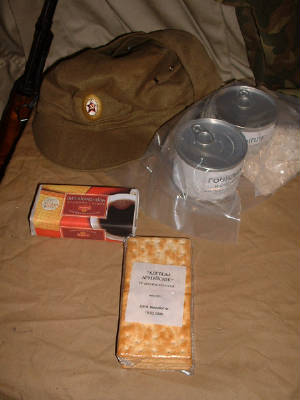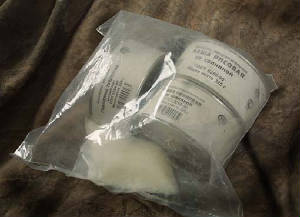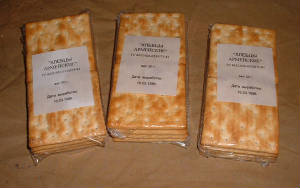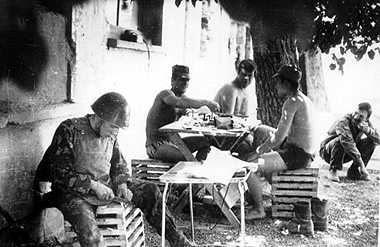|
The results of this research did not just motivate troop command and rations directorates,
but reached into the highest office of the Kremlin. Leonid Brezhnev is quoted as saying: “We should not only see to
our soldiers having enough of the right foods to continue fighting, we must also take pains to not poison them ourselves”.
Being unable to address all of the sanitation/transportation issues, but realizing
that something needed to be done in a hurry, troop commands were issued two new types of rations:
One was a garrison/company-sized ration, consisting of more canned goods and pan-climatically
packaged dry goods, such as potato flakes, noodles, barley, oats, pasta, buckwheat, bread mixes and soup bases. This was easier
to transport or air-supply, had much improved shelf life, and could be prepared by individual soldiers or mess sections, even
though it was by no means a portable ration that could be issued to individual troops for dismounted operations. (There is, however, an instance where a Russian soldier was found to carry three (!!!) 6-pound tins of
corned beef in his small pack when he was captured).
The other was the “Improved” or “Mountain” ration introduced
in spring of 1980. While still quite similar to the less-than desirable “Preserved” ration of the 1970s in many
aspects (multiple bright-metal tins and white labels with accessory items in a plain plastic bag), the Mountain ration was
scaleable from the outset, and could be ordered by commanders based on mission needs as either a “basic” ration
(supplied as an occasional substitute for mess hall or group-feeding rations), or an “enhanced” ration with supplements
aside from the food stuffs contained in the ‘basic’ pouch. Each pouch was meant as a 24-hour ration for low-activity
garrison or guard duty in relatively manageable weather conditions when a field mess was impractical. The ‘basic’
mountain ration came in the following configurations:

|
| MENU "A"--With Supplemental Biscuit and Loaves |
Menu
“A”
-Two
cans of meat dishes. These could be any combination of: ‘Chicken
with
Dumplings’, ‘Chicken with Noodles’, ‘Beef with Vegetables’, ‘Ham
and
Potatoes’ or ‘Stewed Beef with Tomatoes’. Interestingly enough,
these
cans actually had pop-tops like most cans in use today, but the
lids
and pop-and-pry assemblies were not very sturdy. They are also
missing
any instructions/safety warnings as one would see on Western
cans
of this type.
-One pack of Kasha (Instant Gruel/Porridge). This
came in both Buckwheat and Oatmeal Varieties,
flavored either with Pork, Chicken or Fruit
flavor. As the clear plastic package was simply
stamped “Instant Kasha”, no one ever quite knew
what
they would have for breakfast.
-Three tagged tea bags, laconically marked “Tea”
on the front of the tag
and
“Sufficient for ½ Liter (16oz)” on the back.
-Three servings of sugar, in clear bags imprinted “SUGAR”, containing 15gr
(1/2oz) each

|
| Menu "B"--Note the Bar Codes! |
Menu
“B”
-Two cans of Kasha with
meat (buckwheat Kasha)
in
either pop-tops (on this ration after 1981)
or
standard tins requiring a can opener. An
interesting aside on this is that most of the
Kasha tins were
marked with bar-coded labels
as far back as 1980
-One can of Kasha with
fruit (Oatmeal Kasha).
These were also bar-coded
-Three
tagged tea bags, as in Menu “A”
-Three
servings of sugar, as in Menu “A”
Menu
“C”
-One can of meat (Tushonka)
or a Meat Dish as supplied in Menu “A”
-One can of Fish (Sprats)
in commercially labeled tin (Both Pop-top and
standard tins encountered)
-One can of Vegetables or a Potato dish (Both pop-top and standard tins
encountered)
-One tagged tea bag in
a plastic bag
-One
unmarked plastic bag of a fruit drink mix (From personal test, flavor appears to be “Yellowish and sweet” and
“Pinkish and sweet”—no really distinguishable taste past that)
-One plastic pack with
4 sugar tablets marked “SUGAR”
Listed
as ‘Supplemental Food’, additional add-on ration components were issued on an as-needed basis. Even though the
issue of this sort of supplement was often mishandled by both the supply system and requesting commanders, it was generally
well received by the frontoviks who had to battle both the enemy and the unforgiving terrain and weather of Afghanistan. (In
one case a Colonel with a group of female ‘assistants’ instructed his supply officer that all available lots of
a chocolate wafer be delivered to his office, only).
These
supplemental rations were designed to bump the scant average 1,200 calorie count of the Mountain Ration up to twice or thrice
that value for both overall health and stamina of troops engaged in vigorous activity including combat. Even the ‘Basic’
portion of the mountain ration was recognized as being too little food, and was generally supplemented by issuing fresh foods,
cheese and bread alongside them.
Need Some Red Repro Rations?
Reenacting or Paintballing Chechnya or the Day the Bear went over the Mountain?
This will open in a new window, Comrade!
Authorized
issues of ‘Supplemental Food’ included:
1
or 2 packs of sweet biscuits or wafers in assorted flavors. Some were plain white wrappers, others featured commercial labels,
depending on the manufacturer. These were generally well liked by troops, and packed a nutritional punch at approx. 500 calories
per package. These generally were eaten with tea as a light in-between meal on stops or while securing a perimeter. The biscuit
varieties were frequently crushed up and soaked in the tea to make a sweet cereal-like meal.
50gr
paper bags/wraps of assorted hard candy. Even though these were excellent to keep one’s mouth moist and a good source
of calories, the fact that these were wax-paper label wrapped candy in paper bags allowed them to melt in one’s pocket,
stick to most anything, and constantly be peppered with sand and dirt. Many troops would actually carry small leather pouches
to secure their candy stash.
1
or 2 packs of sugar. These were either plastic packs of loose granulated sugar, or plastic-sealed sugar tablets.

|
| "ARMY LOAVES" High Nutrition Crackers |
1
or 2 packs of “Army Loaves” crackers
1
or 2 tins of additional meat rations (80gr “Sausage Stuffing” was
fairly common)
1
or 2 tins of Jam (50gr) or honey
1
tin (10-16oz) of condensed soup, generally commercially labeled
1
Vitamin candy/day
Make sure to bookmark this page- More pictures and articles coming soon.
Upcoming articles:
-Red
Scorpion Fodder--Specialist Rations
-For
a Few Rubles More--Rations purchased from shops
-Eating
While Opposing Muslim Uprisings Part Deux--The IRP-P ration used in Chechnya
|

